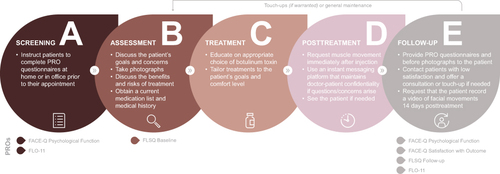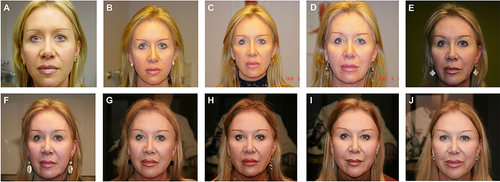Figures & data
Figure 1 The patient journey in facial aesthetics. (A) Screening, (B) assessment, (C) treatment, (D) posttreatment, and (E) follow-up.

Box 1 Optimal Screening Strategies
Box 2 Optimal Assessment Strategies
Box 3 Optimal Treatment Strategies
Box 4 Optimal Posttreatment Strategies
Box 5 Optimal Follow-Up Strategies
Figure 2 Representative photographs of a patient treated with onabotulinumtoxinA over an 18-year period. This patient began receiving onabotulinumtoxinA in December 2000, but no digital photographs were available until 2006. Photos were taken upon arrival to the clinic, and images from an interval of approximately every 1–2 years are shown as follows: 2006 (A), 2008 (B), 2010 (C), 2012 (D), 2014 (E), 2016 (F), 2018 (G), 2020 (H), 2022 (I), and 2023 (J). On average, the patient received 3 sessions per year from March 2006 (age, 43 years) to June 2023 (age, 60 years), totaling 58 clinic visits, including 5 touch-ups. The total dose of onabotulinumtoxinA per treatment session for glabellar frown lines, horizontal frontal rhytids, and canthal lines varied between 40 and 60 units.

